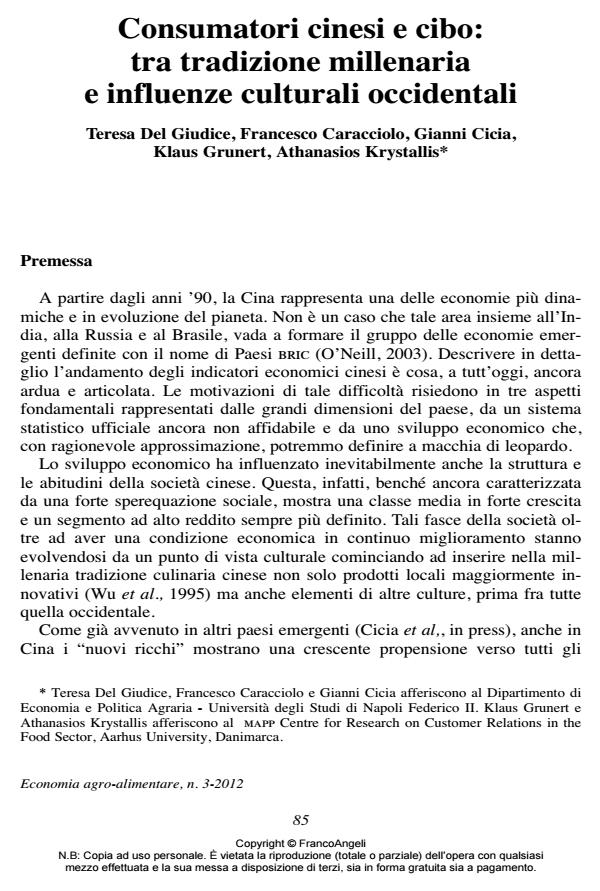Consumatori cinesi e cibo: tra tradizione millenaria e influenze culturali occidentali
Titolo Rivista ECONOMIA AGRO-ALIMENTARE
Autori/Curatori Teresa Del Giudice, Francesco Caracciolo, Gianni Cicia, Klaus G. Grunert, Athanasios Krystallis
Anno di pubblicazione 2012 Fascicolo 2012/3 Lingua Italiano
Numero pagine 15 P. 85-99 Dimensione file 293 KB
DOI 10.3280/ECAG2012-003005
Il DOI è il codice a barre della proprietà intellettuale: per saperne di più
clicca qui
Qui sotto puoi vedere in anteprima la prima pagina di questo articolo.
Se questo articolo ti interessa, lo puoi acquistare (e scaricare in formato pdf) seguendo le facili indicazioni per acquistare il download credit. Acquista Download Credits per scaricare questo Articolo in formato PDF

FrancoAngeli è membro della Publishers International Linking Association, Inc (PILA)associazione indipendente e non profit per facilitare (attraverso i servizi tecnologici implementati da CrossRef.org) l’accesso degli studiosi ai contenuti digitali nelle pubblicazioni professionali e scientifiche
China is one of the most dynamic economies of the planet. The dramatic economic development in recent decades has greatly influenced the structure and habits of Chinese society. This although still characterized by strong disparities between the poorer classes and the wealthy, shows a growing middle class and an increasingly high-income segment. These segments of society are, as expected, evolving from a cultural point of view beginning to incorporate into the ancient Chinese tradition elements of other cultures, most notably the Western one. As was the case for other new economies, especially the rich part of the population is showing an increasing inclination towards all aspects of Western culture. This opening is also affecting the food consumption habits, transforming the dynamic and vibrant Chinese market into a major destination for European food products. The following research by submitting a questionnaire to 500 Chinese consumers residents in metropolitan areas had a dual objective. The first involved the analysis of the propensity of consumers to enter into the ancient Chinese culinary culture food products from other countries. The second was represented by the attempt to segment consumers, depending on the degree of cultural openness towards non- Chinese food, using both socio-demographic and psychographic variables.;
Keywords:China, food related lifestyle, Schwartz portrait value
Jel codes:D12, C25, Q18
- A concept mapping study on organic food consumers in Shanghai, China Huliyeti Hasimu, Sergio Marchesini, Maurizio Canavari, in Appetite /2017 pp.191
DOI: 10.1016/j.appet.2016.09.019 - Exploring Meal and Snacking Behaviour of Older Adults in Australia and China Behannis Mena, Hollis Ashman, Frank R. Dunshea, Scott Hutchings, Minh Ha, Robyn D. Warner, in Foods /2020 pp.426
DOI: 10.3390/foods9040426
Teresa Del Giudice, Francesco Caracciolo, Gianni Cicia, Klaus G. Grunert, Athanasios Krystallis, Consumatori cinesi e cibo: tra tradizione millenaria e influenze culturali occidentali in "ECONOMIA AGRO-ALIMENTARE" 3/2012, pp 85-99, DOI: 10.3280/ECAG2012-003005